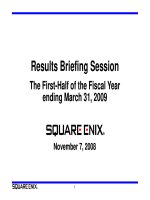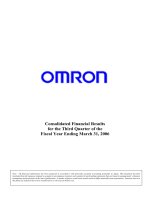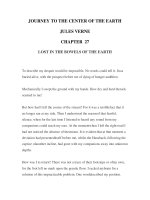Business of The Arts - Storytelling Presentation - March 27 2019
Bạn đang xem bản rút gọn của tài liệu. Xem và tải ngay bản đầy đủ của tài liệu tại đây (361.72 KB, 12 trang )
DC COMMISSION ON THE ARTS AND HUMANITIES
Entrepreneurial and Technical Training for Artists
and Small Business Owners
Spring 2019
STORYTELLING
& PESONAL STATEMENT
Presented by the DC Commission on the Arts and
Humanities, the Department of Small and Local Business
Development, and the Office of Cable Television, Film,
Music, and Entertainment
1
WELCOME
Thank you for joining us for the 2019 spring semester of The Business of the Arts.
During the six-week program, facilitators from the Department of Small and Local
Business Development (DSLBD), Washington Area Lawyers for the Arts, and the
DC Commission on the Arts and Humanities (CAH) will provide arts, humanities
and creative professionals the knowledge and technical support to improve the
sustainability of their business operations. From managing finances to perfecting
your brand story, each session guides you through key components of building a
successful business and increasing your revenue.
The Business of the Arts Professional Development Series is presented in partnership
by CAH, the DSLBD Innovation & Equitable Development Office, and the Office of
Cable Television, Film, Music & Entertainment (OCTFME).
Upcoming classes:
Landscape on Access to Capital, April 3
How to File Your Taxes, April 10
Copyright and Trademark, April 17
Register online at dcarts.dc.gov
2
OVERVIEW
LEARN & TEST PERSONAL STATEMENTS AND PITCHING
Participants will learn how pitch their business to multiple
audiences in multiple ways, and practice pitching to the class.
At its heart, all business is selling, and all selling is storytelling.
This module is about getting to the core of your story, and getting
telling that story no matter where you are or whom you are
speaking with.
ARTIST BIO VS. ARTIST STATEMENTS
Although they seem as though they would be the same, these are actually two,
distinct texts that serve different purposes. After clarifying the differences, we will
break down the components of the Artist Statement and draft one together.
ARIST BIO
Bios are used in your professional package, as part of a catalogue at an exhibition,
in publicity and printed programs, and other promotional materials. Your artist
biography should integrate portions of your resume and artist statement. In general,
bios are more factual about you as an artist, whereas statements are more about the
ideas, concepts and techniques behind your work.
Example:
Anysa Saleh is a San Francisco based Media Artist. She was born and raised in
California’s Central Valley. Saleh later moved to the Bay Area to purse her graduate
degree and earned an MFA in Media Arts from California College of the Arts. She has
exhibited in the United States and abroad. Currently, her work is part of a traveling
show moving from Michigan, New York City, California, and ending in Dubai.
ARTIST STATEMENT
An artist statement is text that accompanies and explains the artist’s intentions of
their body of work. A strong artist statement supplements the visual information in a
portfolio or exhibition so that the reader/viewer can better understand it. Your artist
statement should stand on its own so that the reader can imagine what your work
looks like even if they have not seen it.
Example:
I often wonder what went through my father’s head when he decided to leave Yemen
and raise a family in the United States. Different Among The Different is a piece about
choice. The slow moving visuals ask to choose to stay tuned in and read each word
or watch the Muslim woman continue with her journey, navigating a new city with the
same challenges she’s faced over and over again. The text is a collection of offensive
statements said to me growing up different among the different.
3
ARTIST STATEMENT
Like the elevator pitch, your artist statement helps you make a connection with an
audience, potential customer, grantmaker, investor, etc. It is a living document that
will continually change with you and your work as it develops. An artist statement
may also change based on the body of work you are showing.
LENGTH APPROPRIATENESS
An artist statement generally ranges between 100 – 300 words. A longer artist
statement might describe a large body of work, accompany an exhibition or be used
by curators, journalists, publicists, and critics. A shorter artist statement might be
used to address very specific information about your body of work, and can be used
as an introduction to documents or applications. A super-short artist statement, or
“elevator speech” should be more-or-less memorized, so you can clearly articulate
to viewers what your work is about, both verbally and in writing.
NB: If you’re applying for a grant, follow application instructions regarding length. If
an application asks for a 500 word artist statement – do what they say!
4
What Goes In
DO write a strong, compelling statement that connects the viewer to your work.
DO develop a strong first sentence.
DO keep it as short as possible.
DO focus on topics that may not be apparent from viewing your work.
What Stays Out
DON’T use ‘artspeak’, overly flowery or pretentious language, or art jargon.
DON’T try to impress the reader with vocabulary or extensive knowledge of
art criticism.
DON’T announce what the viewer should feel, just clearly express what you
have accomplished.
ARTIST STATEMENT
WRITING EXERCISE
The best way to get started with an artist statement is to begin writing about your
work in a 10-minute brainstorming session. Do it quickly, and don’t worry particularly
about grammar or word-smithing. There is no structure or format to this. Just write
or type everything that comes to mind about your work. Utilize the Brainstorming
Questions to compete the “Artist Statement Brainstorming” box. If what you
brainstorm sounds more like a fact about you, drop it into the “Bio Brainstorming”
box for later use.
BRAINSTORMING QUESTIONS
• What does your art/product look like? (Size, colors, shapes, textures, light, etc.)
Make your description visual.
• What inspired the piece? Talk about the work from a conceptual, thematic, and/
or emotional point of view.
• Is there a central or guiding image or idea?
• What are its different elements and how do they affect each other or interact?
• What kind of materials did you use/are you using to create the work? Why?
• What was the process of development for the work?
• How does the work use space/relate to the surrounding space?
• What would be the ideal space in which to exhibit or present the work?
• Where does it fit into (or relate to) your awareness of other contemporary work?
Bio Brainstorming Facts
About You
Artist Statement Brainstorming
Ideas, Concepts, Techniques
5
BASIC PITCHING
“Always be closing.” This mantra is controversial, but it covers the idea that every
person a business owner talks to, can be an asset to the business, and in any
conversation there can be appropriate ways to pitch the business. Developing the
elevator pitch and moving beyond it are both incredibly important for ensuring that
you can capitalize on your entire network for support as your business grows.
FOUR BASIC “PITCHES”
Fundamentally a pitch is telling someone about your business in a way that has them
buy into an aspect of your business. They may be a customer or lender, an investor or
lender, a service provider for your business, or simply a business champion.
6
ELEVATOR PITCH
Everyone discusses the importance of an elevator pitch, but the challenge is to
have what you say sound natural and well attuned to your audience. The
challenges are to move away from slogans and having several variations on a
theme. What do you need to say to make someone want to ask questions or
learn more?
CAPABILITIES STATEMENT
Capabilities statements are a staple of the contracting and procurement world.
Standard templates cover what your company can do, and they serve as a functional
résumé for your business. They are less used, in this exact form, in consumer facing
markets. However, the basic concepts of the capabilities statement, and having
one prepared, can help an entrepreneur when deepening an elevator pitch into a
conversation. They also are great drag and drop content when completing other forms.
INTERNET PRESENCE (STATIC PITCH)
There are many ways to have an internet presence, from website through all of
social media. Keeping up with the many ways to have an online presence can be
a job unto itself, but creating static content that covers the same information as
the capabilities statement helps those interested in your business feel confident.
And conversations on social media can be very similar to an elevator pitch, though
it is good to lead back to a static web presence.
INVESTOR PITCH
While the world of investor pitching is constantly adapting, there is a commonly
accepted 11-slide structure for what to present to an investor. It draws from
the lean business canvas. You may never use the slide deck for presenting, but
it is another tool for ensuring that you fully know the critical information about your
company and can cover it on the go.
CONSTANTLY ITERATE
YOUR ELEVATOR PITCH
The elevator pitch is a learning tool, but it is important that it not become a crutch.
The most important piece of an elevator pitch is making a connection with whom
you are speaking with. Thus sometimes it is not the first thing you will say, and you
may only mention your business after you have established a personal connection.
For today’s exercise, estimate one month in your business and when money will flow
in and out of your businesses, totaling the dollars each week on the inflows and
outflows that you built into your lean canvas model.
WRITE OUT 20 VERSIONS
There are different ways to phrase the same thing. Start with writing some general
variations. Then try something completely different. Then define your key personas
and write variations for those persons. Then write variations for someone completely
different (someone likely uninterested at first blush.)
WATCH THE REACTIONS OF PEOPLE
Successful entrepreneurs frequently are very good at reading people’s reactions.
It is a skill, and one that if it does not come naturally can be built through active
considerations of someone’s reactions. Negative reactions are also a learning
opportunity, and some entrepreneurs are very successful despite have repeated
“door” closed in their “face”. One key is for people to find your interest genuine.
ASK FOR ADVICE OF THOSE WHO REACT
Some entrepreneurs chose to be very blunt in asking for advice, even when they
received a negative reaction. Sometimes asking for advice opens a new door, or
presents completely new information. Constantly gathering more information about
reactions helps to refine your approach and your pitch.
DON’T LET NEGATIVE REACTIONS GET YOU DOWN
Was it something I said? Analyze each negative reaction to determine a few things:
(1) was the person having a bad day or overly rushed? (2) is that person just not a
nice person? (3) did you somehow accidentally offend them, and can you repair that?
(4) did you hit too close to something they are interested in doing or already has a
connection who does that work? In all of these things, were there non-verbal cues
you might have noticed before you engaged that would have helped you anticipate
their reaction?
7
ELEVATOR PITCH
WORKSHEET
In today’s exercise we are going to write out twenty actually different variations on your
elevator pitch, pausing every three lines to practice in teams or with the whole group.
1.
2.
3.
4.
5.
6
7.
8.
9.
10.
8
YES, YOU CAN
ITERATE YOUR PITCH AGAIN
1.
2.
3.
4.
5.
6
7.
8.
9.
10.
9
IT’S ALL THE SAME
INFORMATION
Thinking that “I have to have” all of this documentation and preparation can be
overwhelming to many small businesses. Each one of these tools help continue to
clarify for you or for others what you are actually doing. You should use the tools
that feel comfortable to you but that also seem to have salience with your markets,
whether those are consumer markets or other stakeholders in your business.
If you are creating a capabilities statement for government procurement, there are
very specific certifications and identification numbers to include. Much like a résumé,
they may vary industry by industry and from procurement system to procurement
system. If you are doing Federal or DC Government Contracting, the DC Procurement
Technical Assistance Center at DSLBD can provide technical assistance.
10
CAPABILITIES
STATEMENT WORKSHEET
Capabilities Statement Worksheet
For
exercise, we
weare
aregoing
going
through
a capabilities
basic capabilities
For today’s exercise,
to to
talktalk
through
whatwhat
is onisa on
basic
statement
think
about
how
a one-pager
cancan
highlight
thethe
most
important
aspects of
statementto
and
think
about
how
a one-pager
highlight
most
important
your
business.
aspects
of your business.
CAPABILITIES STATEMENT
Include Name & Logo of Company
Contact information of a specific
person, including name, phone, email
Core Competencies
Short introduction relating your company’s core competency specific to your
clients’ needs, followed by key-word heavy bullet points
Tips for creating your capabilities statement:
•
•
•
•
•
•
Use short sentences. If you use periods on one bullet, use them in all
bullets.
Tailor your capabilities statement the same way you would a résumé.
If you have specific products or services, list those clearly.
The capabilities statement should be one page.
The capabilities statement should use the same font, colors, and branding
that your website and other branding materials use.
Only distribute a PDF version.
Past Performance
Differentiators
List any similar work you have
completed and the customers you
supported. If possible, include specific
references and their contact
information
List what makes you better than the
likely competitors for the business you
are seeking.
Company Data
Relevant Codes
If relevant, add specific data about the
company if it relates to the work you
are seeking.
If relevant, add data like a DUNS
number, NAIC codes, NIGP codes, and
any certifications
Add the logo, address, phone, web, and other general contact information.
11
11
ABOUT
CAH
Established in 1968, the DC Commission on the Arts and Humanities
supports programs that promote progress in the arts and humanities
through grants, professional opportunities, and other services to
individuals and nonprofit organizations in all communities within the
District of Columbia. CAH is the designated state arts agency for the
District of Columbia, and is supported primarily by District government
funds and in part by the National Endowment for the Arts.
DSLBD
The Department of Small and Local Business Development supports
the development, economic growth, and retention of District-based
businesses, and promotes economic development throughout the
District’s commercial corridors.
OCTFME
The mission of the Office of Cable Television, Film, Music, and Entertainment
is to produce and broadcast programming for the District of Columbia’s
public, educational, and government access (PEG) cable channels and
digital radio station; regulate the District of Columbia’s cable television
service providers; provide customer service for cable subscribers; and
support a sustainable creative economy and labor market the District of
Columbia.
12









